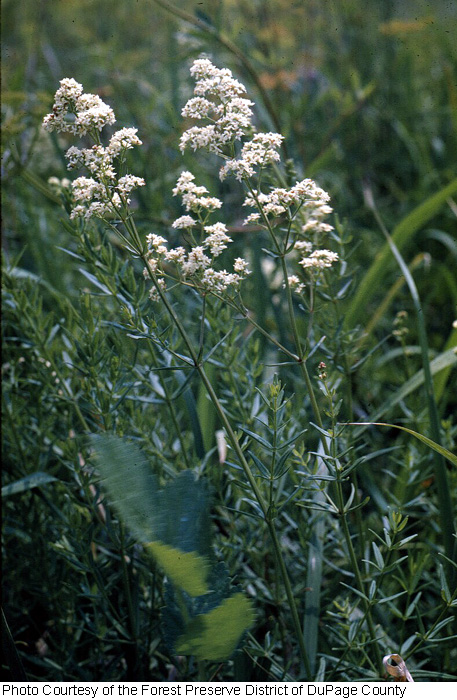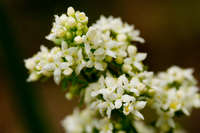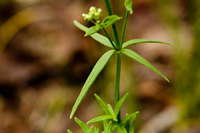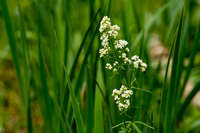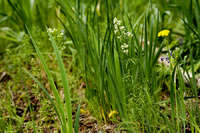Plant: perennial herb; 3-6 dm high, nearly glabrous, erect
Leaves: 4 per node, 13-31 mm long, linear to broadly lanceolate, 3-veined, minutely scaberulous, the apices mostly obtuse
INFLORESCENCE: flowers perfect, numerous in a more or less condensed terminal, nearly leafless panicle of cymules
Flowers: corollas rotate or a little cupped at base, the 4 lobes ovate, the apices blunt; ovaries generally densely hairy with short upwardly-curved hairs
Fruit: FRUITS dry, with short bristles, the mericarps becoming reniform
Misc: Meadows, streamsides, moist shady places; 2150-2900 m (7000-9500 ft); Jun-Aug
REFERENCES: Dempster, Lauramay T. 1995. Rubiaceae. J. Ariz. - Nev. Sci. 29(l): 29.
Perennial herb with a creeping rhizome 20 cm - 0.8 m tall
Leaves: in whorls of four, stalkless, 1.5 - 4.5 cm long, to about 5 mm wide, linear lance-shaped with a minutely rounded tip, three-veined, hairy-fringed (ciliate), sparsely hairy on the lower surface.
Inflorescence: a terminal, branched, showy cluster (cymose panicle) of numerous flowers, about 10 cm long and wide.
Flowers: white to creamy, 3.5 - 7 mm wide, more or less flat and circular in outline, with four short lobes. Lobes about 1 mm long and wide, pointed. Stamens four, alternating with lobes, shorter than corolla. Styles two, short.
Fruit: dry, indehiscent, 2 mm wide, spherical, paired, separating when ripe, sometimes shortly hairy, one-seeded.
Stems: numerous from base, ascending to upright, slender, four-angled, branched, short-bearded just beneath the nodes, sometimes minutely rough-hairy.
Similar species: No information at this time.
Flowering: late May to early September
Habitat and ecology: Found in a variety of habitats, including prairies, moist meadows, and fields.
Occurence in the Chicago region: native
Etymology: Galium comes from the Greek word gala, meaning milk, referring to the plants that are used to curdle milk. Boreale means "from the North."
Author: The Morton Arboretum
[Deam recognizes three varieties based upon differences in fruit indument.] [Fruits of var. boreale have long straight hairs. This form is] restricted to the lake area. Our specimens are from moist, sandy soil along railroads and roadsides and one is from a tamarack bog. [Variety hyssopifolium has glabrous fruit. It is] restricted to the lake area and found in dry, sandy soil along railroads and roadsides, and less frequently in bogs and marshes. [Variety intermedium has short appressed or incurved hairs. This form is] local in the lake area in moist, sandy soil in black oak woods, on borders of lakes, and along roadsides.
Duration: Perennial
Nativity: Native
Lifeform: Subshrub
General: Suffrutescent perennials,30-80 cm tall, stems angled, often winged, erect to decumbent or reclining, sometimes onto leaves and stems boring plants, herbage hispid, the hairs appressed backwards or down.
Leaves: Small, thin, linear to broadly lanceolate, appearing whorled, stiff and firm, distinctly 3-nerved, 20-50 mm long.
Flowers: Bright white, small, 3-4 mm in diameter, perfect or unisexual, not closely subtended by bracts, pedicellate, borne in terminal panicles or in glomerules, or flowers solitary in the axils.
Fruits: Paired fruits, tuberculate, glabrous or finely hispidulous, indehiscent, not fleshy and seperating at maturity. Seeds with a deeply concave face.
Ecology: Found in meadows and on damp slopes from 6,000-9,500 ft (1829-2896 m); flowering July-September
Notes: The keys to this species are the woody caudex, the retrorsely appressed hairs, the stiff, broadly or linear-lanceolate leaves with 3 distinct nerves, and the white flowers.
Ethnobotany: Used as a contraceptive and abortifacient, as a diuretic, as a dye, and it was also considered by some to be poisonous.
Etymology: Galium is from the Greek word gala, milk, an allusion to the fact some species are used to curdle milk, while boreale means northern.
Synonyms: None
Editor: LCrumbacher, 2011
Erect perennial 2-8 dm, the numerous stems commonly short- bearded just beneath the nodes, otherwise glabrous or scaberulous; lvs in 4's, glabrous or scabrous, lance- linear, 1.5-4.5 cm, 3-nerved, the tip minutely rounded, not mucronate; sterile axillary branches with smaller lvs often developed; fls numerous in terminal, rather showy cymose panicles, with white or slightly creamy cor 3.5-7 mm wide; fr 2 mm, glabrous or with short, straight or curled (not hooked) hairs; 2n=44, 66. In a wide variety of not too dry habitats; circumboreal, s. in Amer. to Del., Ky., Mo. and Calif. June, July.
Gleason, Henry A. & Cronquist, Arthur J. 1991. Manual of vascular plants of northeastern United States and adjacent Canada. lxxv + 910 pp.
©The New York Botanical Garden. All rights reserved. Used by permission.


